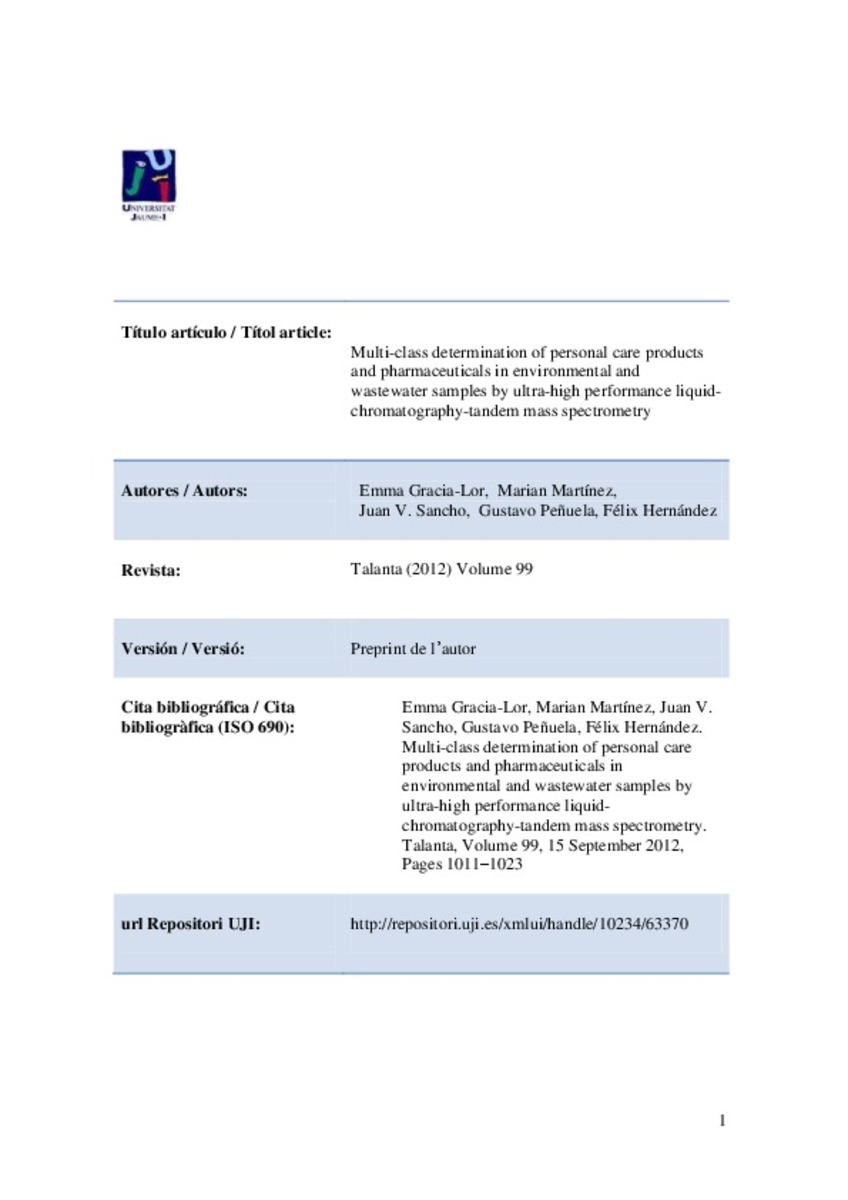Mostrar el registro sencillo del ítem
Multi-class determination of personal care products and pharmaceuticals in environmental and wastewater samples by ultra-high performance liquid-chromatography-tandem mass spectrometry
| dc.contributor.author | Sancho, Juan V | |
| dc.contributor.author | GRACIA LOR, EMMA | |
| dc.contributor.author | Hernandez, Felix | |
| dc.contributor.author | Martínez, Marian | |
| dc.contributor.author | Peñuela, Gustavo | |
| dc.date.accessioned | 2013-05-14T09:25:25Z | |
| dc.date.available | 2013-05-14T09:25:25Z | |
| dc.date.issued | 2012-09 | |
| dc.identifier.uri | http://hdl.handle.net/10234/63370 | |
| dc.description.abstract | In this work, a multi-class method for the simultaneous determination of 17 emerging contaminants, including pharmaceuticals and personal care products, has been developed. Target analytes were two anti-inflammatories, a lipid regulator agent, two angiotensin II antagonists, two antiepileptic drugs and a diuretic. Among personal care products, four preservatives and five UV filters were included. The method is based on solid-phase extraction (SPE) using Oasis HLB cartridges followed by ultra-high performance liquid chromatography–tandem mass spectrometry (UHPLC–MS/MS). Up to three simultaneous transitions per compound were acquired to assure a reliable identification. A detailed study of the extraction process efficiency and matrix effects was carried out in surface water and effluent wastewater. The use of isotope-labeled internal standards (ILIS) was tested to compensate both potential SPE losses during sample extraction and signal suppression/enhancement observed, especially in EWW. Satisfactory correction in all water samples was only ensured when the own analyte ILIS was used. The use of analogues ILIS was a rather useful approach for correction in the majority of the samples tested when analyte ILIS was unavailable. The method was successfully validated in five different surface water (SW) samples and five effluent wastewater (EWW) samples spiked at two concentration levels (0.05 and 0.5 μg/L in SW; 0.1 and 0.5 μg/L in EWW). The developed method was applied to the analysis of 22 samples (SW and EWW) from the Spanish Mediterranean area and 51 reservoir water samples from Colombia. Personal care products were frequently detected, with the highest concentrations corresponding to benzophenone and benzophenone-4 (samples from Spain), and methylparaben (samples from Colombia). Several pharmaceuticals were detected in the Spanish samples, where irbesartan and valsartan – two Angiotensin II antagonists that are not commonly monitored in the aquatic environment – were the compounds most frequently detected. | ca_CA |
| dc.format.extent | 12 p. | ca_CA |
| dc.format.mimetype | application/pdf | ca_CA |
| dc.language.iso | eng | ca_CA |
| dc.publisher | Elsevier | ca_CA |
| dc.relation.isPartOf | Talanta Volume 99, 15 September 2012 | ca_CA |
| dc.rights.uri | http://rightsstatements.org/vocab/CNE/1.0/ | * |
| dc.subject | Pharmaceuticals | ca_CA |
| dc.subject | Personal care products | ca_CA |
| dc.subject | Ultra-high performance liquid chromatography | ca_CA |
| dc.subject | Tandem mass spectrometry | ca_CA |
| dc.subject | Matrix effects | ca_CA |
| dc.subject | Surface water and wastewater | ca_CA |
| dc.title | Multi-class determination of personal care products and pharmaceuticals in environmental and wastewater samples by ultra-high performance liquid-chromatography-tandem mass spectrometry | ca_CA |
| dc.type | info:eu-repo/semantics/article | ca_CA |
| dc.identifier.doi | http://dx.doi.org/10.1016/j.talanta.2012.07.091 | |
| dc.rights.accessRights | info:eu-repo/semantics/openAccess | ca_CA |
| dc.relation.publisherVersion | http://www.sciencedirect.com/science/article/pii/S0039914012006807 | ca_CA |
| dc.type.version | info:eu-repo/semantics/submittedVersion |
Ficheros en el ítem
Este ítem aparece en la(s) siguiente(s) colección(ones)
-
IUPA_Articles [306]







